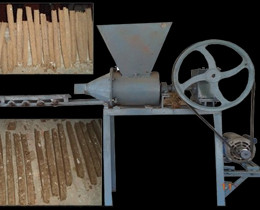

Log Making Machine (1/3 HP)
Rs.48000 Inclusive of all Attachments(Packaging, Cartage and Taxes Extra) Rs.25,000 With Wheel, Yolk and Halas, 6 Disc Harrow and Cultivator(Packaging, Cartage and Taxes Extra)
Making uplas/logs by hands or electricity, using cow dung, is a traditional activity practised in rural India. These uplas are used as fuel and manure. Dried cow dung logs can be used for cremation ceremonies instead of wood, thereby saving 300 kg of wood per cremation. Cow dung logs are also cheaper, as compared to fire wood, electricity or LPG gas. The increasing demand of cow dung uplas/logs led HCF to provide a machine that makes long cow-dung logs and uplas, with minimum human intervention.
A combination of dung and straw (or any agri waste of harvested produce) is mixed and fed into the hopper which is filled in the middle frame of the machine. This mixture is then pressed between two plates, as a result of which it takes the shape. These die-sets are then opened by a hand-operated lever to leave the logs/uplas on the bottom plate. The logs thus made are then put in the sunlight to dry out the moisture inside, making them dry and hard. The machine is capable of making three logs (3 x 3 x 21 inch size) at a time. It can produce about 100-120 logs in an hour. A narrow cylindrical opening has been provided across the length in the centre of the log to facilitate easy drying and efficient combustion. By changing the die, one can also make five rectangular uplas (3x5x10 inch size) at a time. An alternate electric machine is also available.
Advantages
Helps in managing the cow dung at the Gaushala as well as the dairy farm by making value-added products, and increases the income.
Slurry from biogas can also be used for making logs by mixing it with straw or any other harvested crop residue.
Better utilization of agro-waste and eco-friendly application, saves the forest cover.
Dual application - by changing the die, the machine can be used for making upla or logs as per the requirement.
The logs from the machine can be used instead of supporting tree-cutting for the Indian funeral ceremonies.
The machine is extremely time efficient, effective in its production, and safe for the villagers to use.